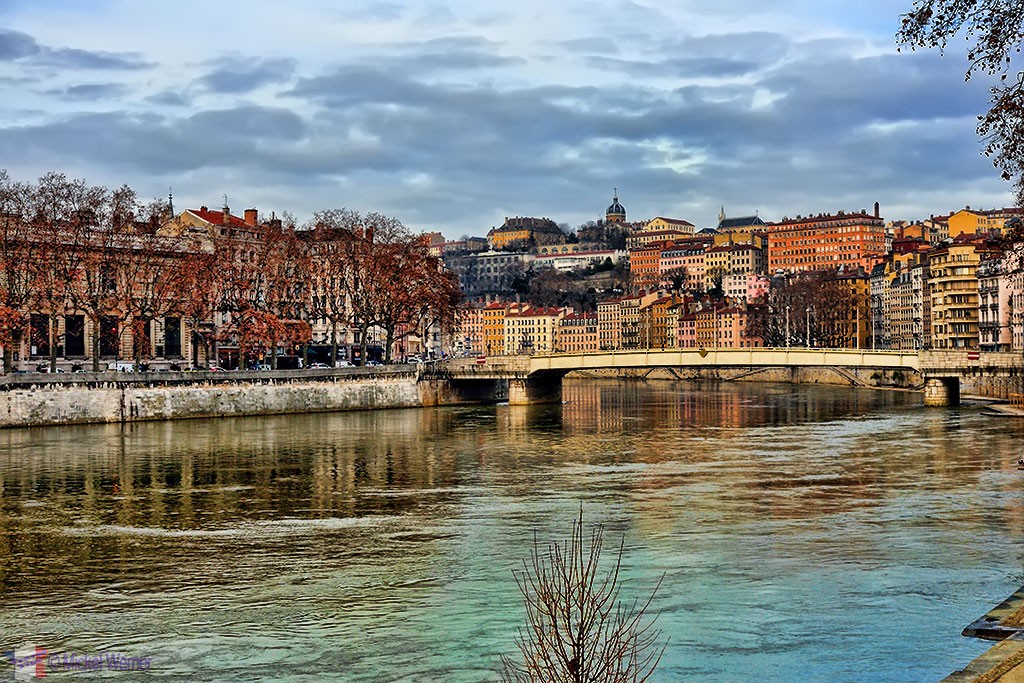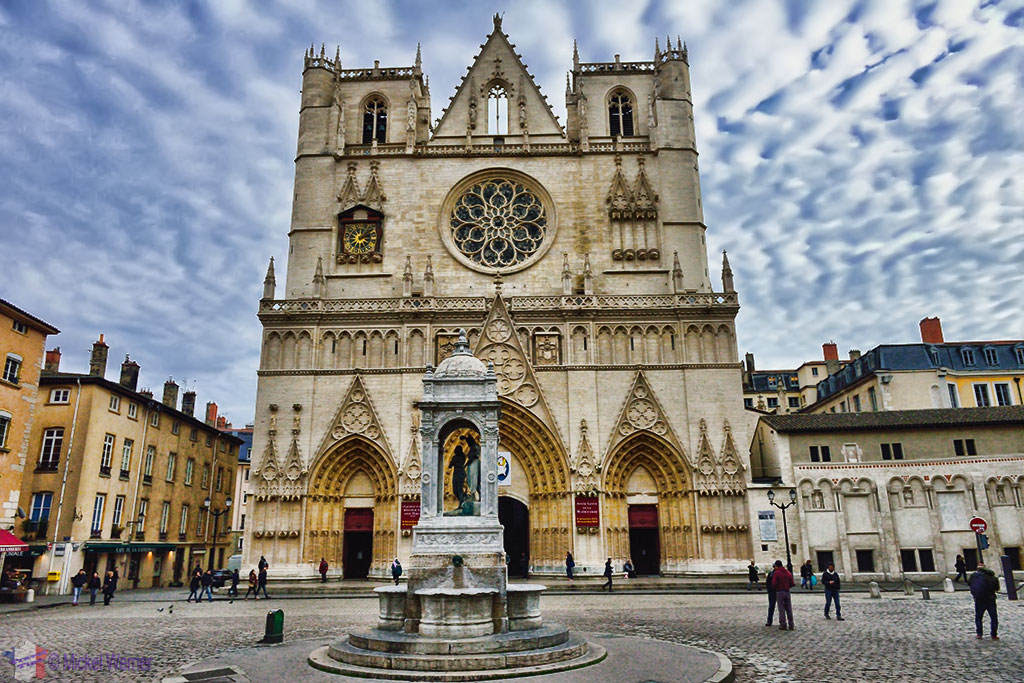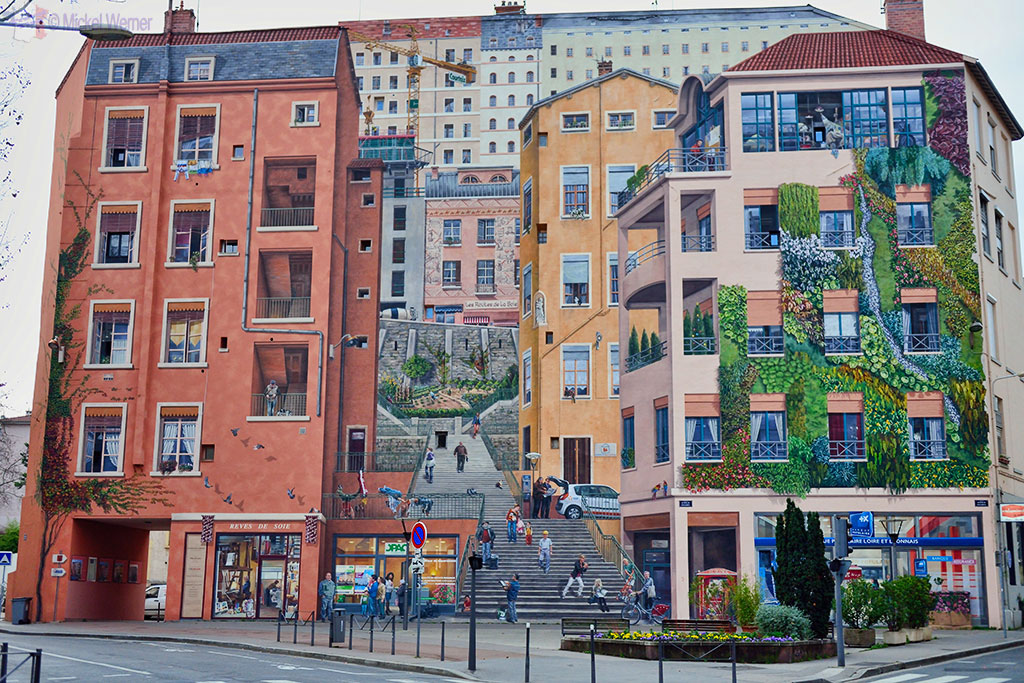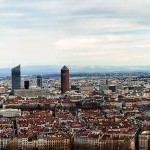This is part 2 of the introduction of the city of Lyon. To read the first part, click here. As a recap, we are walking from the TGV (High Speed Train) railway station to the hills, a 2.5 km walk.
Vieux Lyon – Old Lyon
On the other side of the Bonaparte bridge, crossing the Saone river, is the old city of Lyon (Vieux Lyon). The old city lies at the foot of the Fourviere hill and is considered one of Europe’s most extensive Renaissance areas.
From the Bonaparte bridge you have a great view over the other bridges and both sides of the river.
The hill you see on your right in the photo is where we will end the tour of Lyon.
You can also see the other hills surrounding Lyon. The red bridge you see in the photo is the Saint George pedestrian bridge that leads to the Saint George church. The first thing you see when crossing the Bonaparte bridge is this yellow building with behind it the cathedral and on top of the hill the Basilica church.
It’s actually quite impressive.
The yellow building used to be the Episcopal Palace, and no records could be found for when the palace was actually built, but modifications were made in 1118, so it was built before that time.
Today it’s the municipal library for the 5th arrondissement (district) of Lyon.
It is also used as municipal storage. As can be expected with an Episcopal Palace, it is next to the cathedral:
The cathedral was built in 1180, but since there are so many churches, I’ve made a specific article: Click here to read “Lyon – Some Of The Churches“.
All the streets in Vieux Lyon are old cobblestone streets. There’s very few concrete or asphalt roads to be seen here. The roads are quite uneven, and at times difficult to walk.
TIP: If you have problems walking, or if you are in a wheelchair, I suggest you look for alternative ways of discovering the old town and its hills. I’ve seen tours on tuk-tuk (three wheelers seen in Asia), small cars and even Segways.
Built in the Middle Ages, most houses are still as they were in those days, but often more colourful.
Walking around the old town, you will see many very old houses, often painted in colourful colours.
The old town is also where you’ll find a very interesting museum:
This is the Museum of movie miniatures and film sets. To see more about this amazing museum on our site, click here.
For your information, Lyon is where the cinema was invented. No, not in Hollywood, but in Lyon. The Lumiere brothers made the first movie projector. There is even a museum dedicated to them in Lyon, but I did not have the time to visit it. Maybe in the future.
As with other parts of Lyon, keep looking up the facades.
The streets in the old town are mostly narrow but with sufficient air circulating to not make it suffocating. Apart from the often uneven roads, it’s a pleasant stroll. Your senses come alive with the smells emanating from all the ethnic restaurants in the area.
The streets are quite touristy, with souvenirs shops, fast food restaurants and shops, but never in your face and they are mostly discrete.
But there are also normal and good restaurants and even pubs to be found in the old town. To me it would seem that the number one ethnic restaurant in Lyon is Indian/Pakistani and the number one type pub is Irish.
Most of the streets in this area end in a stairway up the hill, and these stairways are long and quite steep.
The old Lyon town is divided into three different districts. At the Northern end is the last part of the Saint-Paul district. It even has its own railway station:
Here are a few street scenes of the old Lyon:
Notice the stairs… steep?
There are many small courtyards, but you have to look for them. Often they are hidden away in corners and dark alleys.
Stairs everywhere. You can walk around without climbing up, but it means remaining on the lower levels.
The Vieux Lyon is part of the 5th arrondissement of Lyon, and the above photo is the one of the entrances to the Mairie of the 5th district.
A very interesting part of the old Lyon area are the Traboules. In the old days, Lyon’s primary industry was silk and other textiles. For the merchants to be able to bring their silk to their warehouses or shops, they needed passages for when it rained. Silk gets ruined in the rain. So they conceived a large series of passageways leading through the many buildings, enabling the merchants to walk to their shops while keeping dry.
Here is a silk shop and its passageway. The traboules are usually hidden behind doors, and are small and often very dark. Click here to read more about Traboules and see many more photos on our site.
That was the last street scene of old Lyon, I promise.
The Saint George pedestrian bridge is located right next to a church bearing the same name (more of that in the article “Churches of Lyon” coming here shortly).
This is the Bonaparte bridge which we used to cross the Saone river when we came from the Presqu’Ile into the old town.
There are several funiculars (cablecars) operating in the old town bringing you to the top of the hill. One brings you to the Roman theatre, the other brings you to the beautiful basilica.
TIP: Unless you love climbing hundreds of steps, I strongly recommend using the funicular to get to the top. It’s an interesting 1 minute ride.
The Notre Dame of Fourviere Basilica is a remarkable church, so beautiful, you can click here to read a dedicated article on the Basilica on this site.
It is from this church that you get the spectacular views of Lyon. The basilica’s courtyard on both sides gives you an unrestricted view of Lyon:
NOTE: Click on the photo above (or any photo on this site) to see a bigger version popup.
Let’s just have a closer look from where we left:
We started this tour in the middle of the two tall buildings towards the rear. The bridge on the left is the one we crossed over.
On the left of the basilica is the Eiffel Tower.
It’s obviously not the Eiffel Tower, it’s just a radio and TV broadcast mast which looks like the famous Parisian tower, but it was built 3 years afterwards (1892)
Still on the same Fourviere hill that hosts the basilica is an enormous Roman theatre. Remember from the first part of the introduction to Lyon, the city was built by the Romans. So it’s no surprise that we’ll be encountering many signs that the Romans where here.
The theatre is immense, seating over 10,000 people and was built in the year 15 BC. But enough of that, more information and photos of the Roman theatre can be seen on our site by clicking here.
The Mairie of Lyon
We’re now going to head down the hill towards the “Almost Island” again (Presqu’Ile) and go up to the Place des Terreaux square that hosts the main Mairie (City Hall).
The Place des Terreaux square not only has the Mairie but also a fountain made by Frederic Bartholdi (Remember his name? It’s the man who made the Statue of Liberty in New York).
Funny thing is, that the fountain was not made for Lyon. At the age of 23, Bartholdi won a contest for creating a fountain for the city of Bordeaux (South West of France), and when finally it was made, the city deemed it to expensive for them, and they sold it to Lyon.
The four horses represent the four main rivers of France. The 21 ton statue is made out of lead and an iron frame.
The Mairie (1st district) was built in 1645 making it one of the oldest buildings in Lyon.
The building is enormous. One part of the building faces the Place des Terreaux square with the fountain and terraces (and the museum, more on that further on). And on the other side…..
The other side of the Mairie is located on the “Place de la Comedie” (where the Opera is located, more later on below).
This is the employee entrance where the big bosses get to park their cars.
TIP: Normally you can not visit the Mairie interiors, but they do have guided tours of this beautiful building. You need to go to the Tourist Office to reserve a spot, since you can NOT just show up for a tour. Click here to see their tour programs.
Museum of Fine Arts (“Musee des beaux-arts”)
But let’s head back to the initial square, since there is one major building there which I have not shown you yet:
This big building is the Museum of Fine Arts (in French the “Musee des beaux-arts”).
The building in the 17th century used to be a Benedictine convent. The museum itself is one of the most important ones in Europe.
You can enter the museum from 3 different sides. Art ranging from the old Egyptian times to current masterpieces are on permanent display. Click here to access the Museum for more information and for opening times.
Opera
Now back to the other side of the Mairie, the “Place de la Comedie” where we see this “strange” “hybrid” building:
This is the opera building, called the “Opera Nouvel” (Nouvel in this case does not mean “New” but the name of the architect, Jean Nouvel). The original building was built in 1831 (there was one before that, the first freestanding opera in Europe built in 1756, but was deemed too small). In 1985 the Lyon city decided to rebuild the 1831 opera. They gutted the original building, leaving only the facade, and placed a new structure on top of the building. Apparently for architects this was an incredible masterpiece of technical ingenuity.
Here is the view from the Basilica church onto the Presqu’Ile. You can clearly see the black dome of the opera.
The opera seats 1100 people and has several floors for rehearsals, and small presentations. Only the lobby is in its original state.
The mixture of old and new is a bit strange, but not unpleasing. It does have a certain appeal.
For more information about the opera and its program schedule, click here.
Walking back towards the central part of the Presqu’Ile we see many older buildings:
Chambre of Commerce (Palais de la Bourse)
A little further up the road we see this beautiful building:
This used to be the commercial exchange of Lyon, named the Palais de la Bourse (no, not a stock exchange but a goods exchange).
It was built in 1856, and used to have an art and industry museum, shops, change agents and silk brokers, the Chamber of Commerce and the Commercial Court. Today, only the Chamber of Commerce remains in this building (it is also the place where French President Sadi Carnot was assassinated in 1894).
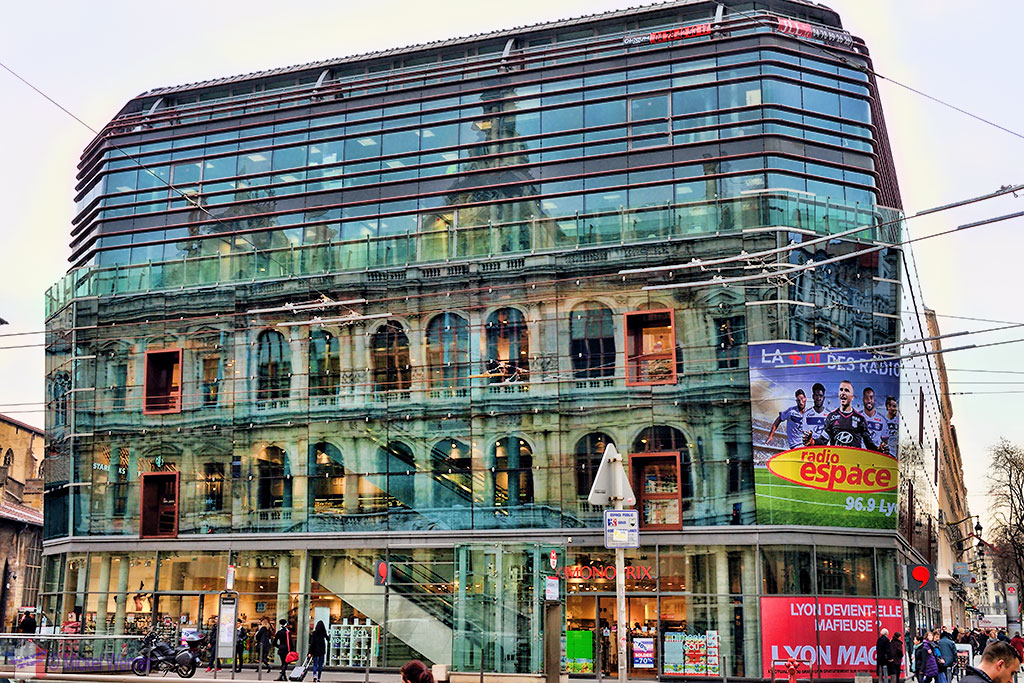
Opposite on the busy street where many of the bus lines and one metro line converge is a small and modern shopping mall. Made out of glass and steel, the Commerce Palace reflects strongly in the building. Eerie, but beautiful..

Next to the mini-shopping mall is an old church, the Saint-Bonaventure church.
From this side of the Presque’Ile we have a nice view of the hill that hosts the Basilica.
While wandering about, looking for the funicular to bring me up another hill, I stumbled upon this building:
I have not been able to find out anything about this squeezed building. There are no signs, and the internet is silent about it.
Anyone know more about this? Leave a comment below…. take me out of my misery.
AND FINALLY…
I’ll leave you with one more photo of a subject I will be covering in more detail in a subsequent article;
This enormous mural painting or fresco is what the French call a “Trompe-L’Oeil” (an optical illusion). It’s a flat and very tall wall (some 7-8 floors) totally painted with scenes of everyday life. It’s amazing, and you can read more about it, and see many more photos on our site by clicking here. The wall is called the “Mur des Canuts”.
Summary
Lyon is an amazing city. It is part of the UNESCO World Heritage sites, and with good reason (you can see all the sites covered by the Unesco Heritage in Lyon by clicking here). It’s quite big and full of visual contrasts. It’s very dynamic and vibrant, and almost anywhere you go, you can eat like a King. Food is delicious and omni-present. Art lovers, history lovers, hikers, architecture buffs, shoppers … everyone gets satisfied.
Lyon is a city that should be seen, even if it means a detour. It’s not a city you can visit in a day or two. At least 3 days are in order to properly see everything that is important.
Other Articles About Lyon On This Site
- Lyon – Introduction – Part 1
- Lyon – The Traboules – Secret Passage Ways
- Lyon – The Roman Theatre
- Lyon – The Amazing Mural Paintings
- Lyon – The Beautiful Basilica Church
- Lyon – Some Of The Churches
- Lyon – The Miniatures and Cinema Museum
- Lyon – Tips: What To Do, What To See in Lyon
Related Posts
- 10000
- 10000
- 10000
- 10000
- 10000
